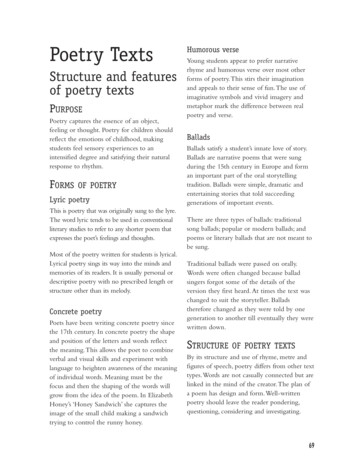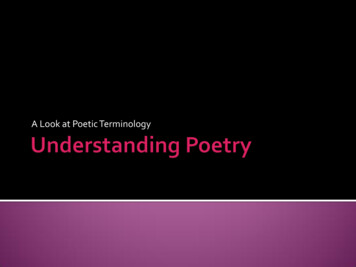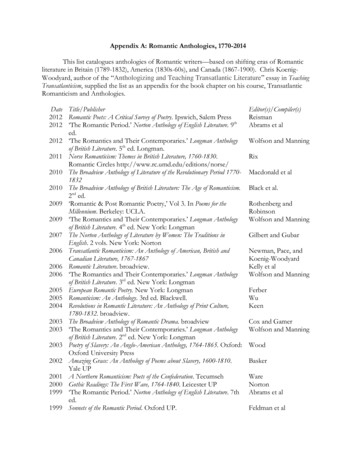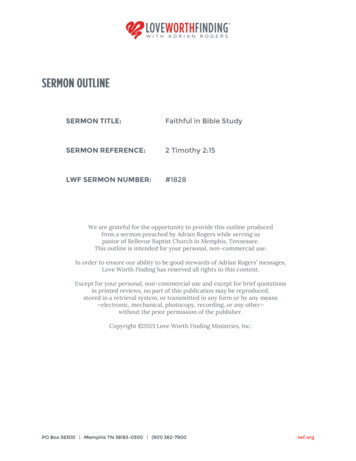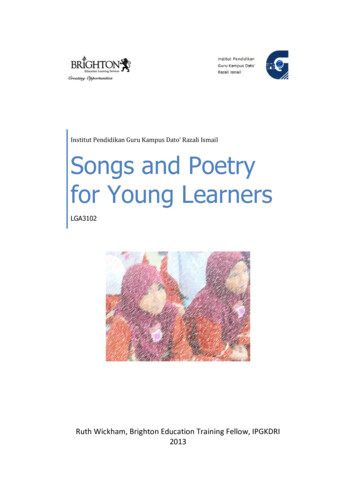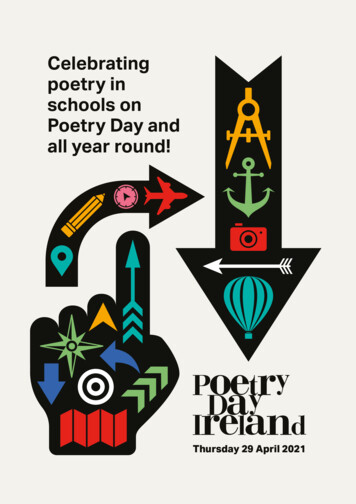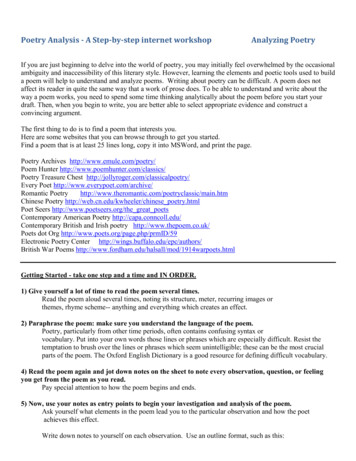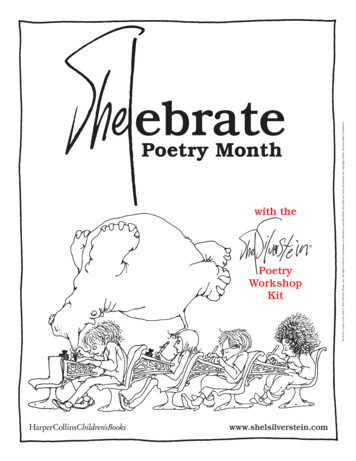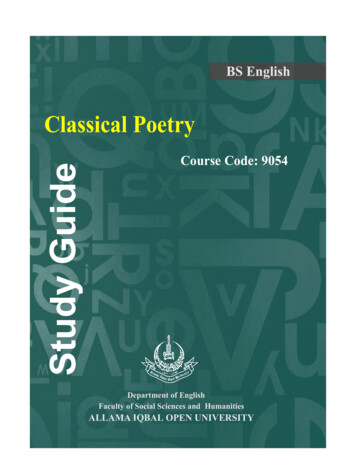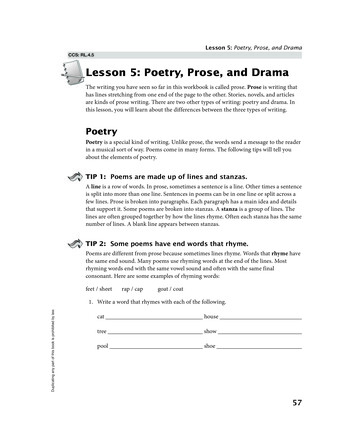
Transcription
Lesson 5: Poetry, Prose, and DramaCCS: RL.4.5Lesson 5: Poetry, Prose, and DramaThe writing you have seen so far in this workbook is called prose. Prose is writing thathas lines stretching from one end of the page to the other. Stories, novels, and articlesare kinds of prose writing. There are two other types of writing: poetry and drama. Inthis lesson, you will learn about the differences between the three types of writing.PoetryPoetry is a special kind of writing. Unlike prose, the words send a message to the readerin a musical sort of way. Poems come in many forms. The following tips will tell youabout the elements of poetry.TIP 1: Poems are made up of lines and stanzas.A line is a row of words. In prose, sometimes a sentence is a line. Other times a sentenceis split into more than one line. Sentences in poems can be in one line or split across afew lines. Prose is broken into paragraphs. Each paragraph has a main idea and detailsthat support it. Some poems are broken into stanzas. A stanza is a group of lines. Thelines are often grouped together by how the lines rhyme. Often each stanza has the samenumber of lines. A blank line appears between stanzas.TIP 2: Some poems have end words that rhyme.Poems are different from prose because sometimes lines rhyme. Words that rhyme havethe same end sound. Many poems use rhyming words at the end of the lines. Mostrhyming words end with the same vowel sound and often with the same finalconsonant. Here are some examples of rhyming words:feet / sheetrap / capgoat / coatDuplicating any part of this book is prohibited by law.1. Write a word that rhymes with each of the following.cathousetreeshowpoolshoe571CCUS04RD01 Text.indd 571/28/2011 12:08:43 AM
Unit 1 – ReadingCCSs: RL.4.5, RL.4.10Usually, each stanza of a poem repeats the same rhyme pattern. Mother Goose poemsare good examples of poems with end rhymes.Read this part of a poem. Think about which words rhyme.fromMy Shadowby Robert Louis StevensonI have a little shadow that goes in and out with me,And what can be the use of him is more than I can see.He is very, very like me from the heels up to the head;And I see him jump before me, when I jump into bed.The funniest thing about him is the way he likes to grow—Not at all like proper children, which is always very slow;For he sometimes shoots up taller like an India-rubber ball,And he sometimes gets so little that there’s none of him at all.2. How many sentences are used in the first stanza?A.B.C.D.12343. What is the rhyme pattern of “My Shadow”?Every line rhymes.Every third line rhymes.Every other line rhymes.Every pair of lines rhyme.4. Which word rhymes with head?A.B.C.D.meseebedcanDuplicating any part of this book is prohibited by law.A.B.C.D.581CCUS04RD01 Text.indd 581/28/2011 12:08:43 AM
Lesson 5: Poetry, Prose, and DramaCCSs: RL.4.5, RL.4.10TIP 3: Many poems have a musical rhythm.Think of your favorite pop music song. Does it make you want to dance to the beat? Ifso, the song has rhythm. In poetry, rhythm means that the sounds of words create apattern.How can words create a pattern? Some sounds in each word are stressed, or said morestrongly. Each sound is called a syllable. For example, the word wonder has twosyllables: won / der. The won syllable is stressed. It is said more loudly than the der.To make rhythm, poets choose words based on which syllables are stressed. They maychoose words that sound like this: TUM-ta. Here, the first syllable is stressed. Or theymay use words that sound like this: ta-TUM. Here, the second syllable is stressed. Apoet could use one of these patterns to make a line with rhythm:ta-TUM ta-TUM ta-TUM ta-TUMNow, let’s use some real words to show rhythm.The moonlit night was warm and bright.Can you hear the pattern of stressed and soft syllables? Now read the poem below.The words of the poem are marked to show the stressed syllables. Those syllables arein bold type. Notice that each line has four stressed syllables.Listen for the rhythm as you read this poem quietly to yourself.The WoodpeckerDuplicating any part of this book is prohibited by law.by Elizabeth Madox RobertsThe woodpecker pecked out a little round holeAnd made him a house in the telephone pole.One day when I watched he poked out his head,And he had on a hood and a collar of red.When streams of rain pour out of the sky,And the sparkles of lightning go flashing by,And the big, big wheels of thunder roll,He can snuggle back in the telephone pole.Well-written prose has rhythm, too. What is different, though, is that the rhythm doesnot just come from the sound of the words. Authors of prose create rhythm by includingdifferent types of sentences in a paragraph. A mixture of shorter and longer sentencescreates a rhythm. The rhythm that words and sentences make helps create emotion forthe reader.591CCUS04RD01 Text.indd 591/28/2011 12:08:43 AM
Unit 1 – ReadingCCSs: RL.4.5, RL.4.10TIP 4: Poets often repeat words, phrases, lines, or wholestanzas.To repeat is to do something over. Poetry often uses repeated words. Repeating helpscreate rhythm in some poems. It may also help show the important ideas and make apoem easier to remember. Look at these examples from nursery rhymes.Pat-a-cake, pat-a-cake, baker’s man.Row, row, row your boat . . .Hickory, dickory, dock,The mouse ran up the clock;The clock struck one,The mouse ran down;Hickory, dickory, dock.Read the poem and answer the question that follows.Tired Timby Walter de la MarePoor tired Tim! It’s sad for him.He lags the long bright morning through,Ever so tired of nothing to do;He moons and mopes the livelong day,Nothing to think about, nothing to say;Up to bed with his candle to creep,Too tired to yawn, too tired to sleep:Poor tired Tim! It’s sad for him.A.B.C.D.He lags the long bright morning through,Ever so tired of nothing to do;He moons and mopes the livelong day,Poor tired Tim! It’s sad for him.It’s a poem! It’s a story! It’s—a narrative poem!Narrative poems are a little more like stories than other poems are. They havebeginnings, middles, and ends. For example, “The Woodpecker” tells a story, doesn’t it?A woodpecker makes a house for himself and snuggles in his home when it rains. But“The Woodpecker” is still very much a poem, too. It has rhythm, and it is told usingstanzas instead of paragraphs.Duplicating any part of this book is prohibited by law.5. Which line is repeated in the poem?601CCUS04RD01 Text.indd 601/28/2011 12:08:43 AM
Lesson 5: Poetry, Prose, and DramaCCS: RL.4.5TIP 5: Poets often use alliteration, assonance,and onomatopoeia.Alliteration is the use of words that begin with the same consonant sound.Alliteration helps give writing a special musical sound. Here are some examplesof alliteration at work:Peter Piper picked a peck of pickled peppers.She sells seashells by the seashore.Prose writers sometimes use alliteration, but not as often as writers of poetry do. Here’san example of alliteration from the Wizard of Oz.“Which road leads to the Wicked Witch of the West?” asked Dorothy.“There is no road,” answered the Guardian of the Gates. “No one ever wishes to gothat way.”Assonance is the use of words that have the same vowel sound. Here are some examples:Joe hoped he could joke about his broken bone.In June, the duke bought two new flutes and a blue tuba.Though prose might sometimes contain assonance, it is more often a feature of poetry.Onomatopoeia is using words that sound like what they mean. Here are someexamples:moohissbuzzmeowplopsizzleDuplicating any part of this book is prohibited by law.Poets often use many of these words together to help readers more fully imagine thesounds.The splash, the gush, the whisper of waterand the whistling whoosh of hissing winds,splattering, battering the leaves and rooftops—the rumble and grumble as thunder begins.Prose writers also use onomatopoeia, but not usually so heavily. Compare this exampleto the rainstorm example:Outside, Elena could hear the first whispers of rain drizzling on the distant trees.Soon the water began to splash in puddles and the wind began to rush. Finally, dullrumbles warned of the cloudburst to come.611CCUS04RD01 Text.indd 611/28/2011 12:08:44 AM
Unit 1 – ReadingCCSs: RL.4.5, RL.4.10Read the poem below, and answer the questions that follow.Shade and Shadowby Mike ActonI heard a cricket creakingAs I stood in silence peekingDown a long and narrow pathway to the village through the trees.Then I saw a wee bug flashingAs its little wings went thrashingAnd its greenish flame winked off and on a dozen times at me.I heard an owl calling(As the evening dew was falling)From the black and brittle branches of an ancient, brooding tree.The moon made shade and shadowThrough the oaks, and though I had noCause to stop, I paused to hear the night winds sighing over me.And I noted, slowly pokingDown the lane, a chorus croakingAs a hundred frogs together sang along the silver stream.Through the trees bright stars were winking,And I paused in silence thinkingLife is full of greater beauty than the sweetest of our dreams.A.B.C.D.Then I saw a wee bug flashingAnd its greenish flame winked off and on a dozen times at me.From the black and brittle branches of an ancient, brooding tree.Life is full of greater beauty than the sweetest of our dreams.Duplicating any part of this book is prohibited by law.6. Which of the following lines from the poem is the best example of alliteration?621CCUS04RD01 Text.indd 621/28/2011 12:08:44 AM
Lesson 5: Poetry, Prose, and DramaCCS: RL.4.57. Which of the following lines from the poem is the best example of assonance?A.B.C.D.I heard an owl calling(As the evening dew was falling)And I noted, slowly pokingThrough the trees bright stars were winking,8. Which of the following lines from the poem has an example of onomatopoeia?A.B.C.D.I heard a cricket creakingThe moon made shade and shadowThrough the oaks, and though I had noAnd I paused in silence thinking9. Write two more examples of alliteration from the poem.TIP 6: Some poems are written in free verse.Duplicating any part of this book is prohibited by law.Free verse is poetry that does not have a set pattern of rhythm or rhyme. It depends onthe natural rhythm of the language to make its music. This doesn’t mean that free versewon’t ever have end rhyme. Sometimes it will. Sometimes parts of a free-verse poem willhave a set rhythm, too. But there will be no pattern of rhyme or rhythm through thewhole poem.Look at the poem on page 64. The poet doesn’t make the lines rhyme. He doesn’t use aset rhythm or lines of the same length. Still, the poem paints clear pictures in ourminds. It makes its own special music. The poet has chosen the words and placed themon the page to create his own effect.631CCUS04RD01 Text.indd 631/28/2011 12:08:44 AM
Unit 1 – ReadingCCSs: RL.4.5, RL.4.10Read the poem and answer the questions that follow.Theme in Yellowby Carl SandburgI spot the hillsWith yellow balls in autumn.I light the prairie cornfieldsOrange and tawny gold clustersAnd I am called pumpkins.On the last of OctoberWhen dusk is fallenChildren join handsAnd circle round meSinging ghost songsAnd love to the harvest moon;I am a jack-o’-lanternWith terrible teethAnd the children knowI am fooling.10. Place a checkmark next to each line that has only four syllables.11. Circle any end-rhyme words. If there are no end rhymes, write “None” on theline below.You have seen how a poet uses words to create rhythm. Meter is a pattern of rhythmthat repeats throughout the poem. Each use of the pattern is called a foot. A foot maytake many forms:ta-TUM (one unstressed syllable, one stressed syllable)TUM-ta (one stressed syllable, one unstressed syllable)ta-ta-TUM (two unstressed syllables, one stressed syllable)TUM-ta-ta (one stressed syllable, two unstressed syllables)Duplicating any part of this book is prohibited by law.TIP 7: A pattern of rhythm is called meter.641CCUS04RD01 Text.indd 641/28/2011 12:08:44 AM
Lesson 5: Poetry, Prose, and DramaCCSs: RL.4.5, RF.4.4bAnd so on. Often, a poem will include four or five feet in a line. Look at the followingexample.In a house in the woods on a bright, sunny day,seven mice made a kite and then flew it away.12. How many feet are used in each line?A.B.C.D.1234Meter is not used in prose. Sentences and paragraphs, like free verse, may have theirown rhythms. But no pattern controls the rhythm of an entire story.TIP 8: Read prose and poems aloud with feeling.When you are asked to read prose and poetry aloud, follow the rhythm of the words.Speak carefully so you do not trip over words. Speak slowly enough so that your wordsdo not run together. But you should also speak with energy. Don’t slow down to a crawlunless the story or poem calls for it. Last, understand the feeling of what you arereading. Put that feeling into your voice.DramaDuplicating any part of this book is prohibited by law.Drama is a kind of story that is meant to be performed by actors. It includes plays,movies, and TV shows. Plays are dramas acted out in front of a live audience. Drama iswritten in the form of a script. A script tells actors what to say and do, but it does notinclude many details because the audience will not read it.Playwrights are writers of plays. Their job is not the same as the job of fiction writers.Most prose writers include lots of information about their characters. They tell what thecharacters look like, how they dress, and so on. They also have to explain the settings oftheir stories, such as the time of day and the place. A playwright doesn’t have to tellabout these things. The audience can see the characters and settings for themselves.Drama is very different from poetry. Writers of poetry use words to create pictures inreaders’ minds. Drama uses spoken words, scenery, and objects to show audiences whathappens in a story.651CCUS04RD01 Text.indd 651/28/2011 12:08:44 AM
Unit 1 – ReadingCCS: RL.4.5TIP 9: A play is divided into acts and scenes.Plays are often broken into acts and scenes. A scene is made up of all the action thatoccurs in a given place and time. If the place or time changes, a new scene begins. Thechange of scenes is usually shown by the stage lights going dark. An act is a group ofscenes. Plays may include one act or several.Prose writers often use chapters to split up scenes or sections of a story. They do notlabel scenes, but blend one into the next. Poetry is much shorter than drama and prose,and its parts are often broken into stanzas.TIP 10: Plays do not explain as much as stories.As you have learned, scripts do not include manydetails. The audience members can see thecharacters and the set for themselves. Also, prosewriters can tell readers how characters feel andthink. Playwrights cannot do this. Instead, all ofthese things must be shown by what the actors doand say.Playwrights usually explain what the set shouldlook like. The director uses this information tobuild the set. The information is often simple andleaves many choices up to the director.13. Give two reasons that plays explain charactersand settings less than stories do.More Drama Termscast – the characters in aplay and the actors whoplay themdirector – the person whois in charge of how theactors perform, how the setis built, and so onprops – objects the actorsuse in the play, such asnewspapers, dishes, orswordsstage – a raised floor onwhich actors move andspeaktheater – a building witha stage and seats for theaudienceDuplicating any part of this book is prohibited by law.set – the stage and sceneryused in a play661CCUS04RD01 Text.indd 661/28/2011 12:08:45 AM
Lesson 5: Poetry, Prose, and DramaCCS: RL.4.5TIP 11: The dialogue and actions in a play are very important.Remember, plays don’t use details the way prose does. The characters’ dialogue andactions tell the audience about the characters. It also helps the audience follow the plot.TIP 12: Stage directions give information about the actorsand the set.Stage directions tell how and where the actors should move on the stage. They alsotell how the set should look. Playwrights use stage directions to give informationabout things such as lighting and set changes. They also use stage directions to tellhow an actor should say a certain line. These directions are usually placed insideparentheses ( ) and printed in italic type.Here is a script for the first scene of a play about the great hero Hercules.Hercules and the Apples of Zeusa Greek mythadapted for the stage by Red GomezCAST OF CHARACTERSTHE PROFESSOR, a narratorHERCULES, a mythical Greek heroATLAS, Titan giant who carries the world on his backDuplicating any part of this book is prohibited by law.ACT ONE,SCENE ONESETTING: A bare stage, except for a speaker’s stand from which THEPROFESSOR speaks. A spotlight shines on THE PROFESSOR. Stage lights comeup showing HERCULES on his journey, carrying a long walking stick.PROFESSOR:Hercules was perhaps the greatest hero in Greek mythology.He was sentenced by the god Apollo to serve a king for twelveyears.671CCUS04RD01 Text.indd 671/28/2011 12:08:45 AM
Unit 1 – ReadingCCSs: RL.4.5, RL.4.10As part of that sentence, Hercules had to perform twelvesuperhuman feats. His journey and suffering earned himeverlasting fame. After eight years, his eleventh dangerouschallenge was to steal golden apples from the garden of Zeus.To do this, he needed help from Atlas, a strong Titan giant.Here we see Hercules beginning his journey.(Stage lights come up. HERCULES moves about the stage slowly, as if on guard.He comes upon ATLAS, who is stooped over and carries a huge globe on hisshoulders.)HERCULES:Atlas, I will carry your load if you will do me a favor.ATLAS:Anything, Hercules, if you will carry my heavy burden.I would be most thankful.HERCULES:Can you bring me Zeus’s golden apples? I must gather them ifI am to survive.ATLAS:I will gladly help you, Hercules.(HERCULES takes the globe, and ATLAS disappears into darkness.)HERCULES:Such a burden bears heavy on the soul as well as on the back.How has Atlas carried this load all these years?ATLAS:These were easy to get, compared to carrying the world on myback. Tell you what, Hercules; I will take these apples to thosewho threaten you.HERCULES:Do that, Atlas. But first, can you hold my burden as I changepositions? I am afraid the weight affects my legs as well as myback.(ATLAS puts the apples down and takes the globe. HERCULES picks up the apples.)HERCULES:Sorry, Atlas. I will be back another time. I will not forget thefavor you have done me. (HERCULES exits running.)(Stage lights dim, except for a spotlight on THE PROFESSOR.)PROFESSOR:Hercules had one more feat to perform before he went downin the record books as the greatest hero in Greek mythology.And that, my friends, will be the subject of our next class.(Curtain)Duplicating any part of this book is prohibited by law.(Stage lights dim to darkness and come back up. Enter ATLAS, carrying the apples.)681CCUS04RD01 Text.indd 681/28/2011 12:08:45 AM
Lesson 5: Poetry, Prose, and DramaCCSs: RL.4.5, RL.4.1014. In the script, what do the stage directions usually tell?A.B.C.D.which character is speakingthe words a character speakshow a character should actthe main setting of the sceneDuplicating any part of this book is prohibited by law.You have learned that there are important differences between prose, poetry, anddrama. Writers of prose give readers information using sentences and paragraphs. Poetsuse words in lines and stanzas to paint pictures in a reader’s mind. Drama is written tobe performed. It uses dialogue and stage directions. Look for the unique elements in thetexts you read. It will help you determine which type of text you are reading.Lesson Practice begins on the following page.691CCUS04RD01 Text.indd 691/28/2011 12:08:45 AM
There are two other types of writing: poetry and drama. In this lesson, you will learn about the differences between the three types of writing. Poetry Poetry is a special kind of writing. Unlike prose, the words send a message to the reader in a musical sort of way. Poems come in many forms. The following tips will tell you about the elements .

